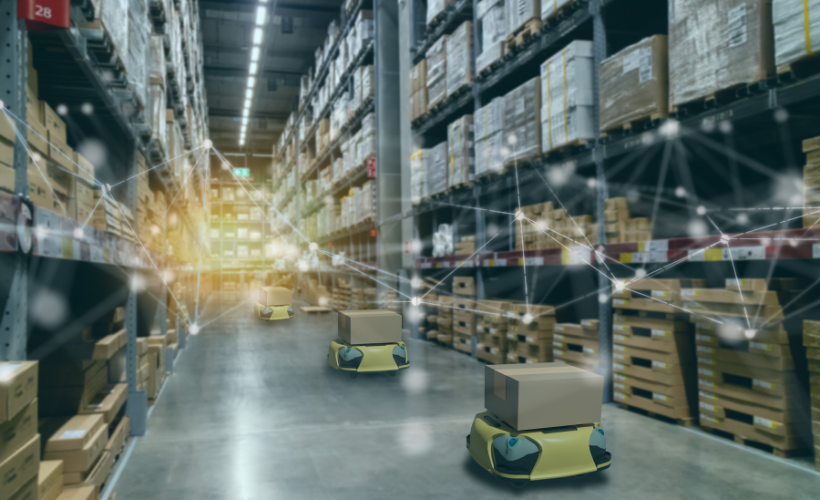The Key Factors to Consider Before Implementing Robots in Your Warehouse
Warehouse robots are increasingly essential in retail, distribution, and manufacturing environments. For years now, robots have been used for single, discreet warehouse tasks. Today, however, robots are being implemented for more and more complex warehouse operations. This increased demand is being driven by multiple factors, including accelerating e-commerce growth, pressure from consumers for faster turnaround on orders, and growing competition for labor.
Could warehouse robots improve your operations and overall performance? Do you know which warehouse automation solutions are optimal for your business?
Here are the key factors to consider before adding robots to your warehouse:
Warehouse robots come in a variety of types, with different capabilities and features
When it comes to warehouse control systems, robots are just another form of automation. That means you are likely already familiar with some types of warehouse robots, while others may be completely new to you. It is important to understand how warehouse automation has evolved and the wide array of features and capabilities now available.
Types of warehouse automation
- Goods-to-person (GTP) solutions utilize an operator based in a centralized location, and the goods move to the operator, rather than the operator moving to the goods. The term “goods-to-person” applies whether the goods are moved by an autonomous robot or some other form of warehouse automation such as a vertical or horizontal carousel or a vertical lift module (VLM). With a true goods-to-person solution, the product picked is a single item or handful of items from a larger inventory stored within that automated media.
- Shuttle systems deliver product without using an operator. For example, a shuttle system or a rail crane can pick up full pallets of product from a high-density pallet storage solution. The product is retrieved and then staged or conveyed through a conveyor system for delivery to the next part of the process such as pick-to-light or a put-wall that is downstream of the storage solution.
Both GTP and shuttle systems can involve machine learning and artificial intelligence (AI) capabilities. This technology now ranges from simple software and autonomous functionality to much more advanced systems with complex sensors and sophisticated predictive analytics.
For example, autonomous mobile robots (AMRs) are gaining traction across a range of distribution environments. Simple AMRs can be programmed and implemented quickly, without a lot of overhead, to accomplish repetitive tasks, such as moving product from one location to another.
Articulating pick robots are also becoming more popular. These robots have the intelligence to discern among mixed products in a single bin, cart, or tote. An articulating pick robot is smart enough to recognize a wanted item, find it, and then move its arm to pick the item. Some can even distinguish damaged items and reject them. When equipped with machine learning, these robots learn about the product base and how best to fulfill orders, and they improve over time.
Understanding the scope of features and capabilities currently available can help you find the warehouse automation solution that will be most useful in your warehouse.
Determining the “why” is critical
It is crucial to identify the specific role robots will play in improving the operation of your facility. Generally speaking, the top reasons companies opt for warehouse automation are to:
- Optimize the footprint of a warehouse facility. Storing and moving items more efficiently makes the most of existing space.
- Improve pick rates without additional labor. The right solution enhances the performance of the current workforce.
- Improve the customer experience. Increasing pick rate and accuracy means customers get their orders fulfilled faster and without error.
- Modernize and automate. Eventually, legacy warehouse systems need to be replaced, especially when maintenance and repair budgets become excessive.
Calculating the ROI of warehouse robots
While evaluating options, be sure to calculate the return on investment (ROI) of different warehouse automation types. First, identify warehouse operations that involve demonstrable, repetitive tasks and determine the hard costs associated them. Then, compare that to the cost of buying or leasing a robot that could assume those responsibilities.
For instance, simple time-and-motion studies of warehouse associates have found 60% of their time is spent walking. Buying or leasing AMRs or other type of warehouse robot can dramatically reduce or eliminate that walking time and result in significant labor cost savings. Warehouse robots can also help businesses adjust to peak season surges and dips.
Robots must be integrated with warehouse processes
To be effective, warehouse robots must be integrated with other warehouse processes. Remember: Warehouse automation is not meant to function as standalone technology. Instead, it needs to be connected to other automation and warehouse processes.
Working with an experienced warehouse automation provider will help you avoid creating islands of robot technology. That’s why it is so important to look for a warehouse robot vendor that can combine warehouse management (WMS), warehouse execution (WES), and warehouse control systems (WCS) into a single package.
The goal is to improve warehouse productivity using technologies that can blend with your current warehouse operations. Ultimately, that solution could involve AMRs, an automated storage conveyance system, pick by light, or another type of warehouse robot. The right vendor will deliver a complete solution that seamlessly integrates today’s automation technology to optimize results.
